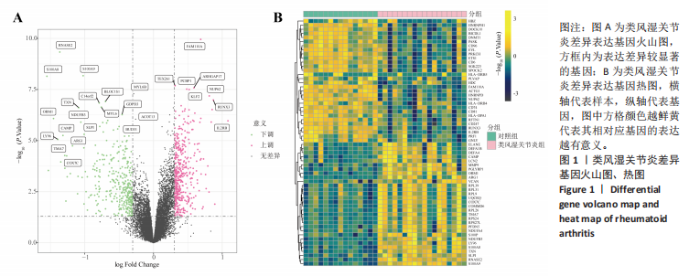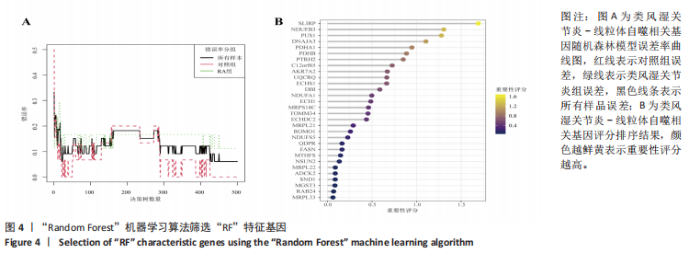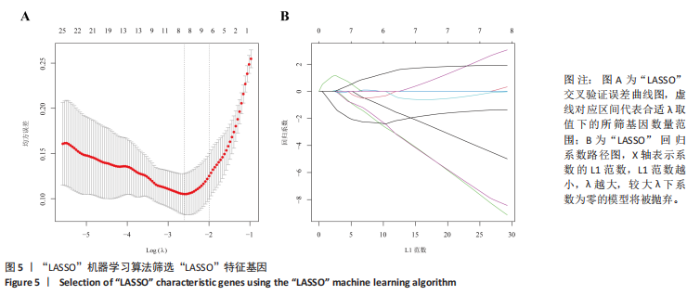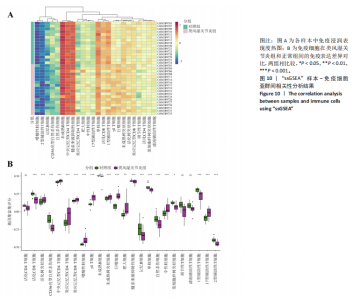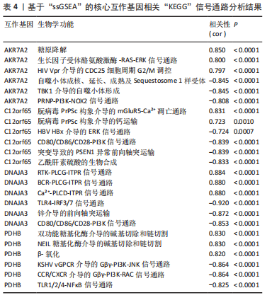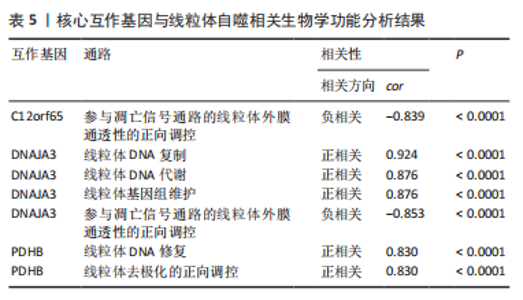Chinese Journal of Tissue Engineering Research ›› 2025, Vol. 29 ›› Issue (在线): 1-15.
The construction and validation of a prediction model based on multiple machine learning algorithms and the immunomodulatory analysis of rheumatoid arthritis from the perspective of mitophagy
Li Jiagen, Chen Yueping, Huang Keqi, Chen Shangtong, Huang Chuanhong
- Ruikang Hospital Affiliated to Guangxi University of Chinese Medicine, Nanning, Guangxi 530011, Guangxi Zhuang Autonomous Region, China
-
Online:2025-01-08Published:2024-09-18 -
Contact:Chen Yueping, Ph D, Chief physician, Professor, Doctoral supervisor, Ruikang Hospital Affiliated to Guangxi University of Chinese Medicine, Nanning 530011, Guangxi Zhuang Autonomous Region, China -
About author:LI Jiagen, Master candidate, Ruikang Hospital Affiliated to Guangxi University of Chinese Medicine, Nanning 530011, Guangxi Zhuang Autonomous Region, China -
Supported by:National Natural Science Foundation of China, No. 82360937 (to CYP); Natural Science Foundation of Guangxi Zhuang Autonomous Region, No. 2023JJA140318 (to CYP); Guangxi Integrated Bone and Joint Degenerative Disease Multidisciplinary Innovation Team Project, No. GZKJ2310 (to CYP [project participant]); Innovation Project of Guangxi Graduate Education of GXUCM, No. YCSY2023040 (to LJG)
CLC Number:
Cite this article
Li Jiagen, Chen Yueping, Huang Keqi, Chen Shangtong, Huang Chuanhong. The construction and validation of a prediction model based on multiple machine learning algorithms and the immunomodulatory analysis of rheumatoid arthritis from the perspective of mitophagy[J]. Chinese Journal of Tissue Engineering Research, 2025, 29(在线): 1-15.
share this article
Add to citation manager EndNote|Reference Manager|ProCite|BibTeX|RefWorks

2.2 “WGCNA”分析结果 “WGCNA”可作为一种初步筛选重要性基因的强大方法,通过对标准化后的矩阵数据进一步处理,发现数据集中无不良样本及基因被删除,然后对所有样本聚类,发现GSM389724与GSM389732两例样本离群,当“cutHeight” =45时,切除离群样本。通过计算不同软阈值的“scale free topology model fit”,继而构建无标度网络(图2A)。随后,集合不同表达水平基因的基因模块将被分离出来,通过聚类分析和动态剪切树法识别模块,并合并相似的模块(图2B)。计算模块特征基因与临床表型(正常对照和类风湿关节炎)之间的相关性,生成相关性矩阵和P值矩阵,继而绘制模块与临床表型的相关性热图(图2C) 。结果显示绿松石色模块(r=±0.66,P=6×10-5)、粉色模块(r=±0.54,P=0.002)意义最显著。提取上述模块基因,其中绿松石色模块含基因970个,粉色模块含基因238个,共有1 208个模块特征基因被认为与临床表型最相关。"

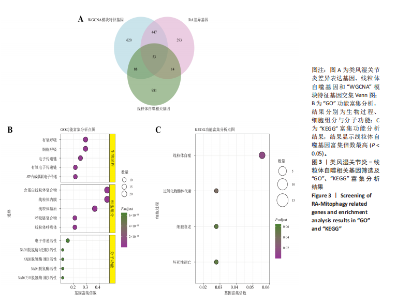
2.3 类风湿关节炎-线粒体自噬相关基因筛选及“GO”和“KEGG”分析结果 从“MitoCarta3.0”数据库中下载人类线粒体特征表达基因,数据集包含1 136个基因,以807个类风湿关节炎差异表达基因基因、1 208个“WGCNA”特征基因和人类线粒体1 136个特征表达基因取交集,获得类风湿关节炎-线粒体自噬相关基因总计53个(图3A)。对上述交集基因进行“GO”和“KEGG”功能富集分析,“GO”富集分析排行前五位的可视化结果显示生物过程主要与有氧呼吸、细胞呼吸、电子传递链、有氧电子传递链、ATP合成偶联电子传递有关,细胞组分主要与含蛋白线粒体复合物、线粒体内膜、线粒体基质、呼吸链复合物、线粒体呼吸体相关,分子功能主要与电子传递活性、NADH脱氢酶(泛醌)活性、NADH脱氢酶(醌)活性、NADH脱氢酶活性、NAD(P)H脱氢酶(醌)活性有关(图3B)。“KEGG”功能富集分析结果包含4条细胞过程通路,富集程度由高到低依次为线粒体自噬、过氧化物酶体代谢、细胞衰老、坏死性凋亡(图3C)。"

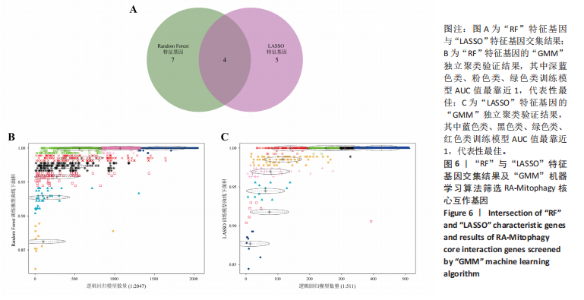
2.6 “GMM”机器学习算法同级验证核心互作基因 将“RF”算法与“LASSO”算法筛选结果取交集,进行Venn图可视化(图6A),取得4个交集基因分别为DNAJA3、C12orf65、AKR7A2、PDHB。通过R函数包“mclust”和“SimDesign”对“RF”和“LASSO”回归分析筛选出的特征基因同时分别进行“GMM”独立聚类验证,“RF”和“LASSO”的基因筛选结果分别被归聚为9个类别,验证“RF”结果下创建了2 047个训练模型(图6B);验证“LASSO”结果下创建了511个训练模型(图6C)。输出两侧最佳模型结果,包括DNAJA3、PUS1、AKR7A2、PTRH2、ECHS1、PDHB、C12orf65、SLC25A5、COX7C共9个基因,而DNAJA3、C12orf65、AKR7A2、PDHB均位于“GMM”算法下最优训练模型基因结果内,因此被筛选作为4个RA-Mitophagy核心互作基因。"

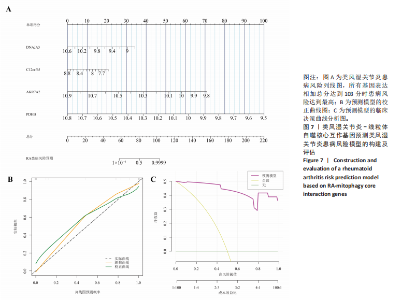
2.7 预测模型构建及验证结果 在二分类逻辑回归分析模式下,对4个RA-Mitophagy核心互作基因进行诊断列线图模型构建,列出各个基因的分数区间,以用来评估基因表达水平在不同分数下的风险贡献,并通过相加每个基因的分数计算出总分,通过总分评估相对应的风险概率。总分越高,患者患得类风湿关节炎的风险越大(图7A)。同时基于Bootstrap方法,重复1 000次,进行模型校正曲线绘制(图7B),以进行内部验证,结果发现校正曲线与理想曲线贴合度高(均方误差 = 0.005 15),证明模型的构建精度良好。进一步构建DCA (图7C),发现预测模型曲线与所有样本全部患病的曲线之间离散度较高,表明模型的临床效用较高。"

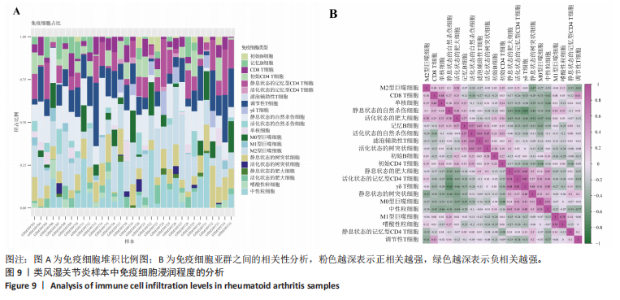
2.9 “CIBERSORT”免疫浸润分析结果 通过“CIBERSORT”算法,利用“MsigDB”数据库的22种免疫细胞“gmt”数据和类风湿关节炎差异基因表达矩阵数据进行免疫浸润分析,进行免疫细胞堆积比例图可视化(图9A)及免疫细胞相关性热图可视化(图9B)。可以直观地看出,呈高正相关性的免疫细胞对有活化的记忆性CD4 T细胞与γδT细胞、活化的记忆性CD4 T细胞与静息态肥大细胞、M1型巨噬细胞与嗜酸性粒细胞、γδT细胞与静息态肥大细胞。其中,γδT细胞与静息态肥大细胞、活化的记忆性CD4 T细胞、静息态树突细胞、M0型巨噬细胞、中性粒细胞均具有较高正相关性。呈高负相关性的免疫细胞对有γδT细胞与静息态 NK 细胞、活化的记忆性CD4 T细胞与静息态 NK 细胞、活化的肥大细胞与静息态树突细胞。其中静息态 NK细胞与静息态肥大细胞、活化的记忆性CD4 T细胞、γδT细胞、静息态树突细胞、M0型巨噬细胞、中性粒细胞多种免疫细胞均有高负相关性。结果表明,在类风湿关节炎线粒体自噬过程中,γδT细胞与活化的记忆性CD4 T细胞的免疫状态较为活跃。"

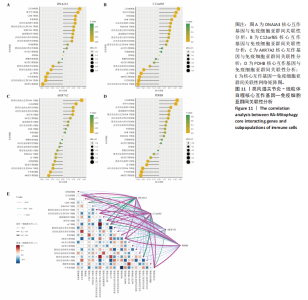
2.11 类风湿关节炎-线粒体自噬核心互作基因—免疫细胞亚群间关联性分析结果 首先,通过R包“ggcorrplot”分析核心互作基因与免疫细胞亚群间的相关性,根据4个核心互作基因的表达矩阵数据与“CIBERSORT”免疫浸润结果数据,利用Shapiro-Wilk检验与封装好的Spearman相关性分析函数进行相关计算,获得基因与免疫细胞亚群间的关联性数据,继而进行核心互作基因—免疫细胞关联性“棒棒糖”图可视化(图11A-D)。图中所示,DNAJA3、C12orf65、PDHB与记忆B细胞间均具有强正相关性,DNAJA3、AKR7A2、PDHB与M0型巨噬细胞均呈强负相关性,此外,C12orf65还与活化的记忆性CD4 T细胞呈强负相关性,AKR7A2与静息态记忆性CD4 T细胞呈强正相关性。 其次,通过R包“linkET”进行汇总性可视化,绘制核心互作基因—免疫细胞亚群间关联性网络矩阵图(图11E)。可以直观地发现,多核心互作基因共同作用时,其中以记忆B细胞、活化的记忆性CD4 T细胞、调节性T细胞、M0型巨噬细胞、中性粒细胞的参与最为重要。同时,可视化网络矩阵图也显示,在类风湿关节炎线粒体自噬过程中,活化的记忆性CD4 T细胞与γδT细胞、静息态肥大细胞之间的正相关表达作用最强,单核细胞和中性粒细胞之间的负相关表达作用最强。 "

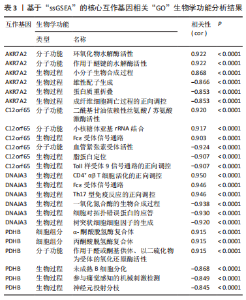
2.12 基于“ssGSEA”的核心互作基因相关生物学功能分析结果 “ssGSEA”算法下共获得821种与RA-Mitophagy核心互作基因相关的“GO”生物学功能(|cor| > 0.8,P < 0.001),其中生物过程数量为600,细胞组分数量为72,分子功能数量为149,并筛选出与每个核心互作基因正相关性和负相关性最强的前三位生物学功能进行展示(表3)。同时获得48条与RA-Mitophagy核心互作基因相关的“KEGG”信号通路(|cor| > 0.8,P < 0.001),同样筛选出与每个核心互作基因正相关性和负相关性最强的前三位信号通路进行展示(表4)。最后,逐条筛选上述全部获得的821种“GO”生物学功能和48条“KEGG”信号通路,发现有6种生物学功能与线粒体自噬密切相关 (表5)。"

| [1] | Bao Zhuoma, Hou Ziming, Jiang Lu, Li Weiyi, Zhang Zongxing, Liu Daozhong, Yuan Lin. Effect and mechanism by which Pterocarya hupehensis skan total flavonoids regulates the proliferation, migration and apoptosis of fibroblast-like synoviocytes [J]. Chinese Journal of Tissue Engineering Research, 2026, 30(4): 816-823. |
| [2] | Li Guangzheng, Li Wei, Zhang Bochun, Ding Haoqin, Zhou Zhongqi, Li Gang, Liang Xuezhen. A prediction model for sarcopenia in postmenopausal women: information analysis based on the China Health and Retirement Longitudinal Study database [J]. Chinese Journal of Tissue Engineering Research, 2026, 30(4): 849-857. |
| [3] | Rong Xiangbin, , Zheng Haibo, Mo Xueshen, Hou Kun, Zeng Ping, . Plasma metabolites, immune cells, and hip osteoarthritis: causal inference based on GWAS data from European populations [J]. Chinese Journal of Tissue Engineering Research, 2026, 30(4): 1028-1035. |
| [4] | Zhang Yibo, Lu Jianqi, Mao Meiling, Pang Yan, Dong Li, Yang Shangbing, Xiao Xiang. Exploring the causal relationship between rheumatoid arthritis and coronary atherosclerosis: a Mendel randomized study involving serum metabolites and inflammatory factors [J]. Chinese Journal of Tissue Engineering Research, 2025, 29(在线): 1-9. |
| [5] | Han Haihui, Ran Lei, Meng Xiaohui, Xin Pengfei, Xiang Zheng, Bian Yanqin, Shi Qi, Xiao Lianbo. Targeting fibroblast growth factor receptor 1 signaling to improve bone destruction in rheumatoid arthritis [J]. Chinese Journal of Tissue Engineering Research, 2025, 29(9): 1905-1912. |
| [6] | Han Haihui, Meng Xiaohu, Xu Bo, Ran Le, Shi Qi, Xiao Lianbo. Effect of fibroblast growth factor receptor 1 inhibitor on bone destruction in rats with collagen-induced arthritis [J]. Chinese Journal of Tissue Engineering Research, 2025, 29(5): 968-977. |
| [7] | Wang Yuru, Li Siyuan, Xu Ye, Zhang Yumeng, Liu Yang, Hao Huiqin. Effects of wogonin on joint inflammation in collagen-induced arthritis rats via the endoplasmic reticulum stress pathway [J]. Chinese Journal of Tissue Engineering Research, 2025, 29(5): 1026-1035. |
| [8] | Liu Yani, Yang Jinghuan, Lu Huihui, Yi Yufang, Li Zhixiang, Ou Yangfu, Wu Jingli, Wei Bing . Screening of biomarkers for fibromyalgia syndrome and analysis of immune infiltration [J]. Chinese Journal of Tissue Engineering Research, 2025, 29(5): 1091-1100. |
| [9] | Yang Dingyan, Yu Zhenqiu, Yang Zhongyu. Machine learning-based analysis of neutrophil-associated potential biomarkers for acute myocardial infarction [J]. Chinese Journal of Tissue Engineering Research, 2025, 29(36): 7909-7920. |
| [10] | Yang Lei, Liu Sanmao, Sun Huanwei, Che Chao, Tang Lin. Comparison of six machine learning models suitable for use in medicine: support for osteoporosis screening and initial diagnosis [J]. Chinese Journal of Tissue Engineering Research, 2025, 29(35): 7499-7510. |
| [11] | Wang Xuepeng, , He Yong, . Effect of insulin-like growth factor family member levels on inflammatory arthritis: a FinnGen biobank-based analysis [J]. Chinese Journal of Tissue Engineering Research, 2025, 29(35): 7656-7662. |
| [12] | Wang Tao, Wang Shunpu, Min Youjiang, Wang Min, Li Le, Zhang Chen, Xiao Weiping. Causal relationship between gut microbiota and rheumatoid arthritis: data analysis in European populations based on GWAS data [J]. Chinese Journal of Tissue Engineering Research, 2025, 29(35): 7663-7668. |
| [13] | Zhu Jiaping, Gao Bo, Lou Chunbiao, Yang Fengyong, Yang Kun. Monomeric traditional Chinese medicine in the treatment of rheumatoid arthritis: regulation of T cell balance [J]. Chinese Journal of Tissue Engineering Research, 2025, 29(32): 6955-6962. |
| [14] | Xie Yizi, Lin Xueying, Zhang Xinxin, Huang Xiufang, Zhan Shaofeng, Jiang Yong, Cai Yan. Biological mechanism of mitophagy in idiopathic pulmonary fibrosis [J]. Chinese Journal of Tissue Engineering Research, 2025, 29(31): 6708-6716. |
| [15] | Su Qin, Jia Siwei, Guo Minfang, Meng Tao, Li Yanbing, Mu Bingtao, Song Lijuan, Ma Cungen, Yu Jiezhong. Lycium barbarum polysaccharide intervenes in SH-SY5Y cell injury induced by beta-amyloid protein 1-42: protective effect of mitochondrial autophagy [J]. Chinese Journal of Tissue Engineering Research, 2025, 29(31): 6688-6696. |
| Viewed | ||||||
|
Full text |
|
|||||
|
Abstract |
|
|||||
